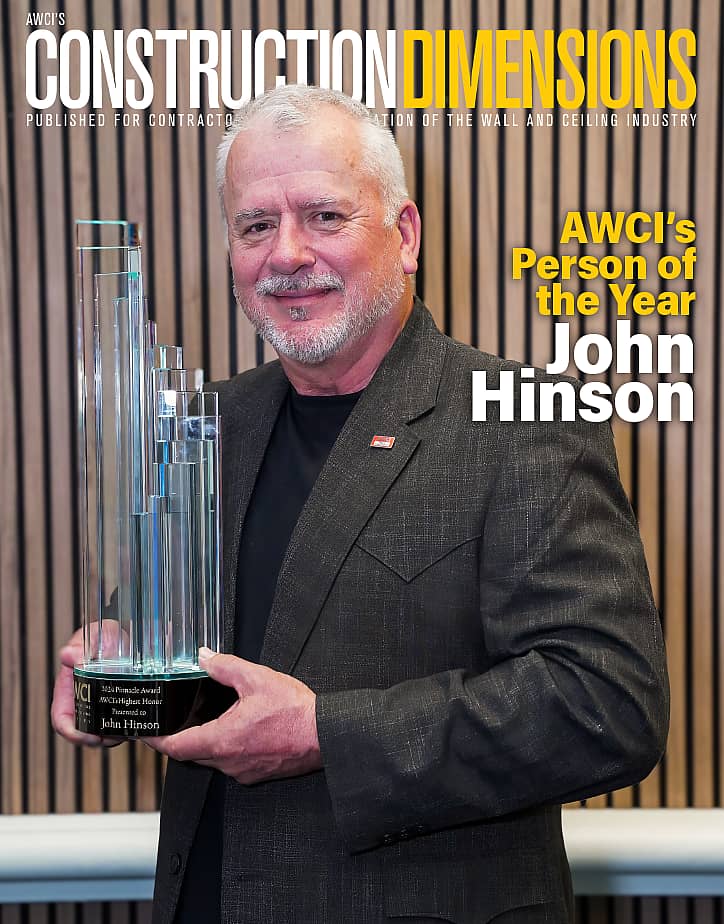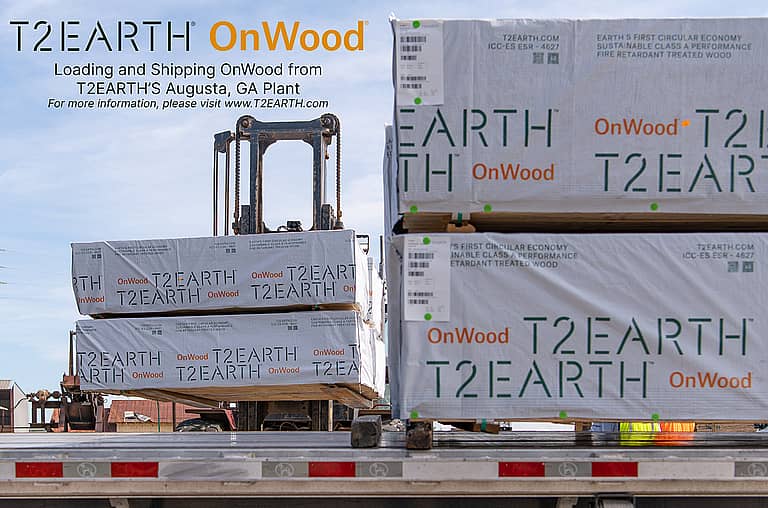We have been sharing AWCI’s history with you for several months, but in this article we present a brief synopsis of each great era. What follows was written by Mark L. Johnson, the author of AWCI’s commemorative centennial book (and frequent contributor to this magazine), “Celebrating 100 Years of Industry Growth with the Association of the Wall and Ceiling Industry.” The book is being released in limited supply at AWCI’s Convention at the end of this month, but you can visit www.awci.org (click on “Centennial” in the upper left corner) for much more.
1918–1919
War and disease devastated the world in 1918. After the war, the relationship between the government and big business changed. The government gained “direct controls over major areas of the economy” by partnering with business, says the Encyclopedia of American Economic History. To gain a voice, business had to play by new rules set in Washington.
At a time of massive upheaval and uncertainty, CPIA emerged with capable hands at is helm. The government wanted control of the economy to further its war effort. CPIA understood this. From the very start, CPIA worked at high levels of power and influence to bring more business to plasterers.
1920s
An era of prosperity settled upon America after the Great War. Corporate profits, stock dividends and wages all rose during the 1920s. While viewed today as a playful decade, in truth the 1920s brought only “a modest level of comfort” to most people, Encyclopædia Britannica says. Even so, many enjoyed buying a radio, a refrigerator or a motor car.
A building boom was in effect by 1922, but plastering mechanics were in short supply. The Contracting Plasterers’ International Association supported the plasterers and lathers unions, viewing union mechanics as preserving the industry’s trade craft and as its future. “The journeyman of today is the contractor of tomorrow,” Oscar A. Reum, CPIA president, told union plasterers in 1920. Thus, association officials nurtured healthy employer-labor relations.
CPIA also distinguished itself nationally. The association sponsored testing programs and issued national specifications. CPIA officials sat on important government-led industry councils. All of this top-level prominence was providential. Soon, a Great Depression would overwhelm life, and the government would have to exert control over prices and wages like never before. CPIA would be in a position to help.
1930s
The Great Depression saw industrial production plummet and construction come to a standstill. About 11,000 banks closed in the United States. As many as 15 million workers—one-third of the labor force—lost their jobs. Skilled construction workers were disappearing in droves as the 1930s began. The number of working plasterers and lathers dropped 82 percent by 1933.
The Contracting Plasterers’ International Association worked directly with the Franklin D. Roosevelt administration to publish “Supplementary Code of Fair Competition for the Plastering and Lathing Contracting Industry,” which was released June 27, 1934. The code set minimum wages and maximum work weeks for the plastering industry. CPIA was viewed as the industry’s leader.
The government-controlled economy and work programs, however, were a mixed blessing. On the one hand, Roosevelt’s “New Deal” programs put millions to work. On the other hand, the programs often doled out the technical work of plastering and lathing to unskilled laborers. CPIA fought to maintain high standards of work during the decade.
1940s
Despite the war, U.S. unemployment dropped to 1.9 percent by 1943. After the war, the United States enjoyed a postwar nationwide buying spree. “Americans were flush with money,” says one reference.
Manufacturers ramped up production of gypsum board. The buildup came at the right time. World War II created a global housing crisis. Japan lacked lumber to replace its housing stock. Australia faced a materials shortage. Growth in family formation and retuning G.I.s created a boom in U.S. housing. Gypsum board could deliver walls and ceilings faster than wet materials.
Internally, the Contracting Plasterers’ International Association faced troublesome times. Its long-standing president, Oscar A. Reum, died at the age of 78 in 1945. Eddie McDonnell, the association’s secretary and editor of The Plastering Craft, died the following year. Annual conventions ceased for part of the decade due to war. But conventions resumed after the war, and the association experienced growth in membership. In 1949, the sizable California Lathing and Plastering Contractors’ Association voted to affiliate with CPIA, bringing with it 300 new members.
1950s
CPIA convened in 1953 in Detroit.
During the 1950s, the changing needs of America had a dramatic impact on construction. People wanted new homes with more amenities. The building industry developed new approaches to construction to help meet the demands.
The Contracting Plasterers’ International Association made its own sweeping changes. The association had always been headquartered in the city where its elected secretary lived. But in 1954, CPIA relocated permanently to Washington, D.C., sharing space with the National Bureau for Lathing and Plastering. Later, CPIA moved its offices down the street. Also in 1954, after a visit of Japanese construction leaders, Saburo Sugiyama became Japan’s first CPIA member. Another change: Non-union contractors joined the association for the first time in its history.
In 1955, CPIA President Loyd Peterson of Minneapolis, a lather by trade, urged the board to alter the association’s bylaws to admit lathing contractors into membership. Later that year, the association officially changed its name to the Contracting Plasterers’ and Lathers’ International Association.
1960s
The E.F. Venzie Award, named after Edmond F. Venzie of Philadelphia, was the association’s top honor from 1964 to 1981.
The 1960s was a time of hope and dreams, but also tension. East German authorities enclosed West Berlin within a wall. The Cuban missile crisis put fear in Americans. John F. Kennedy was assassinated. Riots shook the Watts neighborhood of Los Angeles. The first human artificial heart implant and human heart transplant occurred. Martin Luther King Jr. was assassinated. In “one giant leap for mankind,” Neil A. Armstrong walked on the moon.
Association membership grew during the 1960s. The Contracting Plasterers’ International Association accepted manufacturers as associate members. The association organized its first regional conferences, expanding to eight in all. Regional conferences improved communication between members and helped stabilize wages. CPIA, now the Contracting Plasterers’ and Lathers’ International Association, also formed agreements with unions, which improved relations with the carpenters, laborers, painters and plasterers.
By the late 1960s, the volume of drywall and acoustical tile contracted by CPLIA members had risen significantly. This led to some introspection on the part of association members and, in 1969, a name change. CPLIA became iaWCC, the international association of the Wall and Ceiling Contractors.
1970s
AWCI (then iaWCC) toured Japan in 1975. Saburo Sugiyama, president of the Japan Plasterers’ Association, said the visit “mark[ed] a new epoch” in association relations.
Whereas the 1960s had created a sense of hope, the 1970s saw repeated disappointment and growing cynicism. It was the decade of Watergate, the Vietnam pullout and Hollywood disaster movies. Americans began to look elsewhere for heroes, such as the Soviet Union’s tiny gymnast Olga Korbut, Brazil’s soccer phenomenon Pelé and Sweden’s dominant tennis star Bjorn Borg.
Throughout the 1970s, the international association of Wall and Ceiling Contractors (AWCI’s predecessor) took steps to better serve the industry. In 1974, iaWCC bought its first headquarters building in northwest Washington for $35,000. It formed WAC/PAC (the Wall and Ceiling Political Action Committee), one of the first business PACs in the United States. It began publishing Construction Dimensions. It accepted large numbers of non-union contractors as members. And in 1977, it formed the Foundation of the Wall and Ceiling Industry to provide industry research and education.
The 1970s saw two association name changes. In 1976, iaWCC merged with the Gypsum Drywall Contractors International to become iaWCC/GDCI. In 1979, iaWCC/GDCI officially became AWCI, the Association of the Wall and Ceiling Industries—International.
1980s
The 1980s began with the U.S. economy on the verge of a recession. Inflation exceeded 13 percent, a tight money supply limited lending for projects, and memories of long gas lines lingered in people’s minds. Yet, in an astounding turnaround, the 1980s saw amazing economic growth and innovation. “Reaganomics” provided tax cuts, budget cuts and less regulation.
New products and market niches helped AWCI members to grow during the 1980s. AWCI worked hard during the decade to provide industry craft training and continuing education for its members.
Also, the 1980s saw growth for the association. Membership increased, and so did participation. The 1980 AWCI Annual Convention in Phoenix had 1,500 attendees. Nine years later 3,000 convened in Las Vegas.
1990s
Although it began with a recession, the 1990s was a prosperous decade. The New York Times said the United States economy grew by an average of 4 percent per year between 1992 and 1999. A National Science Foundation report showed that R&D investment relative to GDP grew by 30 percent between 1994 and 2000. Construction Dimensions reported on the “extraordinary expansion” that occurred during the final six years of the decade.
Industry manufacturers ramped up their product introductions. AWCI’s 1992 convention, its 75th, featured opportunities for contractors to expand their markets. The exposition showcased many products for the first time anywhere—tools to install cornerbead faster, computer estimating and project tracking software, new exterior insulation wall systems, improved fasteners, new ceiling systems, tapeless drywall systems and more.
The 1990s saw AWCI work on some special projects. In 1992, AWCI and the Gypsum Association wrote standards for five levels of drywall partition finishing. GA-214, “Levels of Gypsum Board Finish,” was the first document to instruct wallboard finishers on quality. In 1998, AWCI piloted its first publication in Spanish, the “AWCI Employee Safety Handbook, Spanish Edition.”
Exterior insulation and finish systems continued to gain wide acceptance, and AWCI was at the forefront in providing EIFS education. In 1998, AWCI introduced EIFS—Doing It Right®. In 1998 and 1999, 400 mechanics, inspectors and other industry professionals took the course. Thousands more would take it during the 2000s.
2000s
The decade of the 2000s was as topsy-turvy as they come. The Internet contributed to economic globalization and communication, and reports indicate the world economy nearly doubled in size. But it was an age of turbulence. The dot-com bubble burst. The United States was attacked Sept. 11, 2001. International wars, civil wars, guerrilla wars and coups were prominent in world news. Epidemics such as SARS and the H1N1 virus and disasters such as Hurricane Katrina also made headlines. Then, in 2007 and 2008, a massive housing bubble burst when the market for complex financial derivatives related to home mortgages collapsed.
AWCI’s work during the decade was steady. In 2002, an AWCI task force drafted an immigration policy in response to legislation enacted after 9/11. The policy acknowledged the importance of national security but recommended steps to allow some immigrants to remain in the United States while they applied for residency. In 2003, AWCI Executive Vice President Steve Etkin launched the AWCI Insurance Company, Ltd., which helped EIFS contractors obtain insurance coverage when it was unavailable.
In 2002, the Foundation of the Wall and Ceiling Industry published “Mold: Cause, Effect and Response.” A genus of mold had created a crisis for industry contractors, and the paper explained the problem and its remediation.
In 2005, the association launched AWCI CARES (Caring Action Relief in Emergency Situations). It was the idea of the wives of members of AWCI’s Executive Committee. The women proposed a service funded by the Foundation of the Wall and Ceiling Industry to care for AWCI families in need. Since 2005, hundreds of thousands of dollars have been distributed through the program.
2010s
AWCI conventions and trade shows in recent years have been bustling with attendees and exhibitors.
The Great Recession was ongoing as the 2010s began. Building activity was down, and skilled workers and general laborers were leaving the industry in droves. But instead of stimulating business investment and focusing on job creation, the U.S. government introduced a new national health care system. Eventually, the number of construction projects increased, and AWCI members began to see their backlogs of work grow steadily.
Technology revolutionized the industry during the 2010s. Laser-based optical devices and electronic job-tracking tools improved site workflows. Cloud storage and retrieval, PDF annotation software, 3-D building information modeling and augmented reality led many AWCI members to form Visual Design and Construction departments. AWCI’s Construction Technology Committee worked and AWCI convention seminars helped many contractors stay abreast of the new technologies.
AWCI played a key role in promoting unity among steel suppliers and cold-formed steel framing manufacturers. The association’s efforts, along with a few key industry players, led to the formation of the Steel Framing Industry Association in 2011. AWCI’s board of directors endorsed SFIA’s new Code Compliance Certification Program, which brought standardization in quality to load-bearing and non-load-bearing CFS framing.
The 2010s also saw important immigration issues come to the fore. AWCI participated in the discussion through the 2016 Foundation of the Wall and Ceiling Industry paper, “Immigration: A Solution to Workforce Shortages.” The paper discussed the convoluted, restrictive immigration system and made several practical reform proposals to lawmakers.





